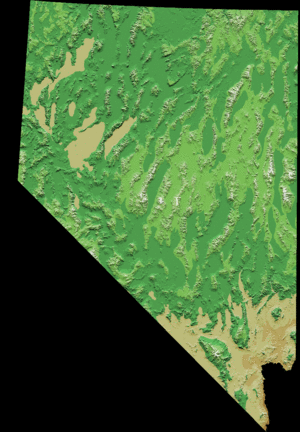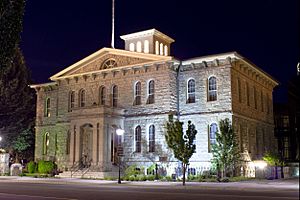Geography of Nevada facts for kids
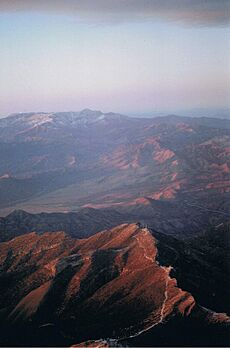
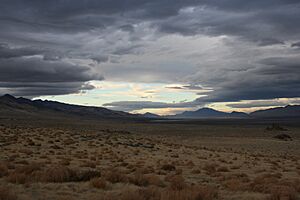
The landlocked U.S. state of Nevada has a varied geography and is almost entirely within the Basin and Range Province and is broken up by many north–south mountain ranges. Most of these ranges have endorheic valleys between them.
Overview
Much of the northern part of the state is within the Great Basin, a mild desert that experiences hot temperatures in the summer and cold temperatures in the winter. Occasionally, moisture from the Arizona Monsoon will cause summer thunderstorms; Pacific storms may blanket the area with snow. The state's highest recorded temperature was 125 °F (52 °C) in Laughlin (elevation of 605 feet or 184 meters) on June 29, 1994. The coldest recorded temperature was −52 °F (−47 °C) set in San Jacinto in 1972, in the northeastern portion of the state.
The Humboldt River crosses the state from east to west across the northern part of the state, draining into the Humboldt Sink near Lovelock. Several rivers drain from the Sierra Nevada eastward, including the Walker, Truckee, and Carson rivers. All of these rivers are endorheic basins, ending in Walker Lake, Pyramid Lake, and the Carson Sink, respectively. However, not all of Nevada is within the Great Basin. Tributaries of the Snake River drain the far north, while the Colorado River, which also forms much of the boundary with Arizona, drains much of southern Nevada.
The mountain ranges, some of which have peaks above 13,000 feet (4,000 m), harbor lush forests high above desert plains, creating sky islands for endemic species. The valleys are often no lower in elevation than 3,000 feet (910 m), while some in central Nevada are above 6,000 feet (1,800 m).
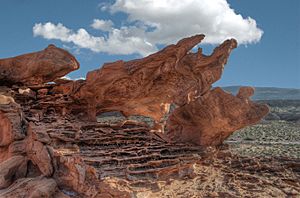
The southern third of the state, where the Las Vegas area is situated, is within the Mojave Desert. The area receives less rain in the winter but is closer to the Arizona Monsoon in the summer. The terrain is also lower, mostly below 4,000 feet (1,200 m), creating conditions for hot summer days and cool to chilly winter nights.
Nevada and California have by far the longest diagonal line (in respect to the cardinal directions) as a state boundary at just over 400 miles (640 km). This line begins in Lake Tahoe nearly 4 miles (6.4 km) offshore (in the direction of the boundary), and continues to the Colorado River where the Nevada, California, and Arizona boundaries merge 12 miles (19 km) southwest of the Laughlin Bridge.
The largest mountain range in the southern portion of the state is the Spring Mountain Range, just west of Las Vegas. The state's lowest point is along the Colorado River, south of Laughlin.
Nevada has 172 mountain summits with 2,000 feet (610 m) of prominence. Nevada ranks second in the United States by the number of mountains, behind Alaska, and ahead of California, Montana, and Washington.
Climate

Nevada is the driest state in the United States. It is made up of mostly desert and semi-arid climate regions, and, with the exception of the Las Vegas Valley, the average summer diurnal temperature range approaches 40 °F (22 °C) in much of the state. While winters in northern Nevada are long and fairly cold, the winter season in the southern part of the state tends to be of short duration and mild. Most parts of Nevada receive scarce precipitation during the year. The most rain that falls in the state falls on the east and northeast slopes of the Sierra Nevada.
The average annual rainfall per year is about 7 inches (180 mm); the wettest parts get around 40 inches (1,000 mm). Nevada's highest recorded temperature is 125 °F (52 °C) at Laughlin on June 29, 1994, and the lowest recorded temperature is −50 °F (−46 °C) at San Jacinto on January 8, 1937. Nevada's 125 °F (52 °C) reading is the third highest statewide record high temperature of a U.S. state, just behind Arizona's 128 °F (53 °C) reading and California's 134 °F (57 °C) reading.
Climate data
| Location | July (°F) | July (°C) | December (°F) | December (°C) | ||||
|---|---|---|---|---|---|---|---|---|
| Max | Min | Max | Min | Max | Min | Max | Min | |
| Las Vegas | 106 | 81 | 41 | 27 | 56 | 38 | 13 | 3 |
| Reno | 92 | 57 | 33 | 14 | 45 | 25 | 7 | –4 |
| Carson City | 89 | 52 | 32 | 11 | 45 | 22 | 7 | –5 |
| Elko | 90 | 50 | 32 | 10 | 37 | 14 | 2 | –9 |
| Fallon | 92 | 54 | 33 | 12 | 45 | 19 | 7 | –7 |
| Winnemucca | 93 | 52 | 34 | 11 | 41 | 17 | 5 | –8 |
| Laughlin | 112 | 80 | 44 | 27 | 65 | 43 | 18 | 6 |
| Climate data for Las Vegas (Köppen BWh) | |||||||||||||
|---|---|---|---|---|---|---|---|---|---|---|---|---|---|
| Month | Jan | Feb | Mar | Apr | May | Jun | Jul | Aug | Sep | Oct | Nov | Dec | Year |
| Record high °F (°C) | 77 (25) |
87 (31) |
92 (33) |
99 (37) |
109 (43) |
117 (47) |
117 (47) |
116 (47) |
114 (46) |
103 (39) |
87 (31) |
78 (26) |
117 (47) |
| Mean maximum °F (°C) | 68.7 (20.4) |
74.2 (23.4) |
84.3 (29.1) |
93.6 (34.2) |
101.8 (38.8) |
110.1 (43.4) |
112.9 (44.9) |
110.3 (43.5) |
105.0 (40.6) |
94.6 (34.8) |
80.5 (26.9) |
67.9 (19.9) |
113.6 (45.3) |
| Mean daily maximum °F (°C) | 58.5 (14.7) |
62.9 (17.2) |
71.1 (21.7) |
78.5 (25.8) |
88.5 (31.4) |
99.4 (37.4) |
104.5 (40.3) |
102.8 (39.3) |
94.9 (34.9) |
81.2 (27.3) |
67.1 (19.5) |
56.9 (13.8) |
80.5 (26.9) |
| Daily mean °F (°C) | 49.5 (9.7) |
53.5 (11.9) |
60.8 (16.0) |
67.7 (19.8) |
77.3 (25.2) |
87.6 (30.9) |
93.2 (34.0) |
91.7 (33.2) |
83.6 (28.7) |
70.4 (21.3) |
57.2 (14.0) |
48.2 (9.0) |
70.1 (21.2) |
| Mean daily minimum °F (°C) | 40.5 (4.7) |
44.1 (6.7) |
50.5 (10.3) |
56.9 (13.8) |
66.1 (18.9) |
75.8 (24.3) |
82.0 (27.8) |
80.6 (27.0) |
72.4 (22.4) |
59.6 (15.3) |
47.3 (8.5) |
39.6 (4.2) |
59.6 (15.3) |
| Mean minimum °F (°C) | 29.8 (−1.2) |
32.9 (0.5) |
38.7 (3.7) |
45.2 (7.3) |
52.8 (11.6) |
62.2 (16.8) |
72.9 (22.7) |
70.8 (21.6) |
60.8 (16.0) |
47.4 (8.6) |
35.2 (1.8) |
29.0 (−1.7) |
27.4 (−2.6) |
| Record low °F (°C) | 8 (−13) |
16 (−9) |
19 (−7) |
31 (−1) |
38 (3) |
48 (9) |
56 (13) |
54 (12) |
43 (6) |
26 (−3) |
15 (−9) |
11 (−12) |
8 (−13) |
| Average precipitation inches (mm) | 0.56 (14) |
0.80 (20) |
0.42 (11) |
0.20 (5.1) |
0.07 (1.8) |
0.04 (1.0) |
0.38 (9.7) |
0.32 (8.1) |
0.32 (8.1) |
0.32 (8.1) |
0.30 (7.6) |
0.45 (11) |
4.18 (106) |
| Average snowfall inches (cm) | 0.0 (0.0) |
0.0 (0.0) |
0.0 (0.0) |
0.0 (0.0) |
0.0 (0.0) |
0.0 (0.0) |
0.0 (0.0) |
0.0 (0.0) |
0.0 (0.0) |
0.0 (0.0) |
0.0 (0.0) |
0.2 (0.51) |
0.2 (0.51) |
| Average precipitation days (≥ 0.01 in) | 3.1 | 4.1 | 2.8 | 1.6 | 1.1 | 0.4 | 2.5 | 2.2 | 1.8 | 1.7 | 1.5 | 3.0 | 25.8 |
| Average snowy days (≥ 0.1 in) | 0.0 | 0.1 | 0.0 | 0.0 | 0.0 | 0.0 | 0.0 | 0.0 | 0.0 | 0.0 | 0.0 | 0.1 | 0.2 |
| Average relative humidity (%) | 45.1 | 39.6 | 33.1 | 25.0 | 21.3 | 16.5 | 21.1 | 25.6 | 25.0 | 28.8 | 37.2 | 45.0 | 30.3 |
| Average dew point °F (°C) | 22.1 (−5.5) |
23.7 (−4.6) |
23.9 (−4.5) |
24.1 (−4.4) |
28.2 (−2.1) |
30.9 (−0.6) |
40.6 (4.8) |
44.1 (6.7) |
37.0 (2.8) |
30.4 (−0.9) |
25.3 (−3.7) |
22.3 (−5.4) |
29.4 (−1.5) |
| Mean monthly sunshine hours | 245.2 | 246.7 | 314.6 | 346.1 | 388.1 | 401.7 | 390.9 | 368.5 | 337.1 | 304.4 | 246.0 | 236.0 | 3,825.3 |
| Percent possible sunshine | 79 | 81 | 85 | 88 | 89 | 92 | 88 | 88 | 91 | 87 | 80 | 78 | 86 |
| Source: NOAA (relative humidity, dew point and sun 1961–1990) | |||||||||||||
| Climate data for Reno (Köppen BSk) | |||||||||||||
|---|---|---|---|---|---|---|---|---|---|---|---|---|---|
| Month | Jan | Feb | Mar | Apr | May | Jun | Jul | Aug | Sep | Oct | Nov | Dec | Year |
| Record high °F (°C) | 71 (22) |
75 (24) |
83 (28) |
90 (32) |
98 (37) |
104 (40) |
108 (42) |
105 (41) |
106 (41) |
93 (34) |
77 (25) |
71 (22) |
108 (42) |
| Mean maximum °F (°C) | 61.2 (16.2) |
65.3 (18.5) |
73.9 (23.3) |
80.9 (27.2) |
89.4 (31.9) |
97.0 (36.1) |
102.1 (38.9) |
100.0 (37.8) |
94.5 (34.7) |
85.0 (29.4) |
71.5 (21.9) |
61.7 (16.5) |
102.6 (39.2) |
| Mean daily maximum °F (°C) | 47.7 (8.7) |
52.1 (11.2) |
59.2 (15.1) |
64.7 (18.2) |
74.1 (23.4) |
84.6 (29.2) |
93.9 (34.4) |
92.1 (33.4) |
83.8 (28.8) |
70.4 (21.3) |
56.7 (13.7) |
46.7 (8.2) |
68.8 (20.4) |
| Daily mean °F (°C) | 36.9 (2.7) |
40.6 (4.8) |
46.6 (8.1) |
51.6 (10.9) |
60.3 (15.7) |
69.2 (20.7) |
77.2 (25.1) |
75.1 (23.9) |
67.0 (19.4) |
55.1 (12.8) |
43.8 (6.6) |
36.2 (2.3) |
55.0 (12.8) |
| Mean daily minimum °F (°C) | 26.1 (−3.3) |
29.0 (−1.7) |
34.0 (1.1) |
38.5 (3.6) |
46.6 (8.1) |
53.8 (12.1) |
60.4 (15.8) |
58.1 (14.5) |
50.3 (10.2) |
39.7 (4.3) |
31.0 (−0.6) |
25.7 (−3.5) |
41.1 (5.1) |
| Mean minimum °F (°C) | 12.2 (−11.0) |
16.1 (−8.8) |
21.3 (−5.9) |
26.2 (−3.2) |
34.0 (1.1) |
41.0 (5.0) |
50.7 (10.4) |
48.5 (9.2) |
39.0 (3.9) |
27.4 (−2.6) |
17.4 (−8.1) |
11.3 (−11.5) |
6.6 (−14.1) |
| Record low °F (°C) | −17 (−27) |
−16 (−27) |
−3 (−19) |
13 (−11) |
16 (−9) |
25 (−4) |
33 (1) |
24 (−4) |
20 (−7) |
8 (−13) |
1 (−17) |
−16 (−27) |
−17 (−27) |
| Average precipitation inches (mm) | 1.25 (32) |
1.03 (26) |
0.80 (20) |
0.44 (11) |
0.55 (14) |
0.41 (10) |
0.20 (5.1) |
0.24 (6.1) |
0.21 (5.3) |
0.50 (13) |
0.62 (16) |
1.10 (28) |
7.35 (187) |
| Average snowfall inches (cm) | 5.2 (13) |
5.2 (13) |
2.9 (7.4) |
0.4 (1.0) |
0.1 (0.25) |
0.0 (0.0) |
0.0 (0.0) |
0.0 (0.0) |
0.0 (0.0) |
0.1 (0.25) |
1.8 (4.6) |
5.2 (13) |
20.9 (53) |
| Average precipitation days (≥ 0.01 in) | 6.9 | 7.0 | 5.5 | 4.5 | 4.4 | 3.1 | 1.7 | 1.6 | 2.0 | 2.9 | 4.3 | 6.6 | 50.5 |
| Average snowy days (≥ 0.1 in) | 3.4 | 3.3 | 2.0 | 0.7 | 0.2 | 0.0 | 0.0 | 0.0 | 0.0 | 0.1 | 1.2 | 3.0 | 13.9 |
| Average relative humidity (%) | 68.0 | 60.2 | 52.7 | 45.9 | 43.2 | 39.9 | 36.2 | 39.3 | 44.0 | 50.7 | 61.2 | 67.6 | 50.7 |
| Mean monthly sunshine hours | 195.6 | 204.2 | 291.0 | 332.1 | 375.8 | 393.8 | 424.0 | 390.8 | 343.9 | 295.2 | 212.0 | 187.5 | 3,645.9 |
| Percent possible sunshine | 65 | 68 | 78 | 83 | 84 | 88 | 93 | 92 | 92 | 85 | 70 | 64 | 82 |
| Source: NOAA (relative humidity and sun 1961–1990) | |||||||||||||
| Climate data for Carson City (Köppen BSk) | |||||||||||||
|---|---|---|---|---|---|---|---|---|---|---|---|---|---|
| Month | Jan | Feb | Mar | Apr | May | Jun | Jul | Aug | Sep | Oct | Nov | Dec | Year |
| Record high °F (°C) | 72 (22) |
76 (24) |
81 (27) |
88 (31) |
94 (34) |
101 (38) |
107 (42) |
105 (41) |
103 (39) |
93 (34) |
79 (26) |
75 (24) |
107 (42) |
| Mean maximum °F (°C) | 59.3 (15.2) |
62.4 (16.9) |
70.7 (21.5) |
77.9 (25.5) |
85.6 (29.8) |
93.6 (34.2) |
99.0 (37.2) |
96.5 (35.8) |
91.9 (33.3) |
82.7 (28.2) |
70.7 (21.5) |
60.5 (15.8) |
99.0 (37.2) |
| Mean daily maximum °F (°C) | 45.5 (7.5) |
49.5 (9.7) |
56.2 (13.4) |
61.7 (16.5) |
70.4 (21.3) |
80.9 (27.2) |
89.5 (31.9) |
87.8 (31.0) |
80.7 (27.1) |
68.0 (20.0) |
54.5 (12.5) |
44.6 (7.0) |
65.8 (18.8) |
| Daily mean °F (°C) | 34.8 (1.6) |
38.3 (3.5) |
43.9 (6.6) |
48.8 (9.3) |
56.6 (13.7) |
65.0 (18.3) |
72.1 (22.3) |
70.2 (21.2) |
63.1 (17.3) |
52.2 (11.2) |
41.4 (5.2) |
34.2 (1.2) |
51.7 (10.9) |
| Mean daily minimum °F (°C) | 24.1 (−4.4) |
27.1 (−2.7) |
31.6 (−0.2) |
35.8 (2.1) |
42.9 (6.1) |
49.2 (9.6) |
54.8 (12.7) |
52.5 (11.4) |
45.6 (7.6) |
36.3 (2.4) |
28.4 (−2.0) |
23.9 (−4.5) |
37.7 (3.2) |
| Mean minimum °F (°C) | 6.9 (−13.9) |
11.7 (−11.3) |
17.4 (−8.1) |
22.3 (−5.4) |
29.7 (−1.3) |
35.8 (2.1) |
44.4 (6.9) |
42.1 (5.6) |
34.3 (1.3) |
21.8 (−5.7) |
11.4 (−11.4) |
6.2 (−14.3) |
0.6 (−17.4) |
| Record low °F (°C) | −27 (−33) |
−22 (−30) |
−5 (−21) |
3 (−16) |
18 (−8) |
25 (−4) |
33 (1) |
26 (−3) |
17 (−8) |
6 (−14) |
−5 (−21) |
−26 (−32) |
−27 (−33) |
| Average precipitation inches (mm) | 1.72 (44) |
1.48 (38) |
1.24 (31) |
0.51 (13) |
0.51 (13) |
0.37 (9.4) |
0.18 (4.6) |
0.14 (3.6) |
0.24 (6.1) |
0.55 (14) |
0.90 (23) |
1.50 (38) |
9.34 (237.7) |
| Average snowfall inches (cm) | 3.6 (9.1) |
1.7 (4.3) |
1.6 (4.1) |
0.0 (0.0) |
0.0 (0.0) |
0.0 (0.0) |
0.0 (0.0) |
0.0 (0.0) |
0.0 (0.0) |
0.0 (0.0) |
0.7 (1.8) |
6.4 (16) |
14.0 (36) |
| Average precipitation days (≥ 0.01 in) | 6.2 | 5.6 | 4.8 | 3.2 | 3.4 | 1.7 | 0.9 | 1.0 | 1.1 | 2.4 | 3.3 | 4.8 | 38.4 |
| Average snowy days (≥ 0.1 in) | 1.8 | 1.4 | 1.0 | 0.1 | 0.0 | 0.0 | 0.0 | 0.0 | 0.0 | 0.0 | 0.6 | 1.4 | 6.3 |
| Source 1: NOAA | |||||||||||||
| Source 2: National Weather Service | |||||||||||||
Flora and fauna
Being the driest U.S. State, and with much of it located within large deserts like the Great Basin Desert and the Mojave Desert, most of Nevada's organisms are adapted to a desert environment.
Even so, the ecosystem of Nevada is diverse and differs by state area. It contains six biotic zones: alpine, sub-alpine, ponderosa pine, pinion-juniper, sagebrush and creosotebush.
It contains 488 species of birds (such as bald eagles and mountain bluebirds), 61 species of mammals (such as desert bighorn sheep and coyotes), 16 species of scorpions, 52 species of reptiles (such as Great Basin rattlesnakes and desert tortoise) and 48 species of fish (such as Lahontan cutthroat trout and mountain whitefish).
Administration
Counties

Nevada is divided into political jurisdictions designated as counties. Carson City is officially a consolidated municipality, meaning it legally functions as both a city and a county. As of 1919, there were 17 counties in the state, ranging from 146 to 18,159 square miles (380 to 47,030 km2).
Lake County, one of the original nine counties formed in 1861, was renamed Roop County in 1862. Part of the county became Lassen County, California, in 1864, resolving border uncertainty. In 1883, Washoe County annexed the portion that remained in Nevada.
In 1969, Ormsby County was dissolved and the Consolidated Municipality of Carson City was created by the Legislature in its place coterminous with the old boundaries of Ormsby County.
Bullfrog County was formed in 1987 from part of Nye County. After the creation was declared unconstitutional, the county was abolished in 1989.
Humboldt County was designated as a county in 1856 by Utah Territorial Legislature and again in 1861 by the new Nevada Legislature.
Clark County is the most populous county in Nevada, accounting for nearly three-quarters of its residents. Las Vegas, Nevada's most populous city, has been the county seat since the county was created in 1909 from a portion of Lincoln County, Nevada. Before that, it was a part of Arizona Territory. Clark County attracts numerous tourists: An estimated 44 million people visited Clark County in 2014.
Washoe County is the second-most populous county of Nevada. Its county seat is Reno. Washoe County includes the Reno–Sparks metropolitan area.
Lyon County is the third most populous county. It was one of the nine original counties created in 1861. It was named after Nathaniel Lyon, the first Union General to be killed in the Civil War. Its current county seat is Yerington. Its first county seat was established at Dayton on November 29, 1861.
| County name | County seat | Year founded | 2021 population | Percent of total | Area (mi2) | Percent of total | Population density (/mi2) |
|---|---|---|---|---|---|---|---|
| Carson City | Carson City | 1861 | 58,993 | 1.88 % | 157 | 0.14 % | 407.80 |
| Churchill | Fallon | 1861 | 25,723 | 0.82 % | 5,024 | 4.54 % | 5.22 |
| Clark | Las Vegas | 1908 | 2,292,476 | 72.92 % | 8,061 | 7.29 % | 290.52 |
| Douglas | Minden | 1861 | 49,870 | 1.59 % | 738 | 0.67 % | 70.24 |
| Elko | Elko | 1869 | 53,915 | 1.71 % | 17,203 | 15.56 % | 3.14 |
| Esmeralda | Goldfield | 1861 | 743 | 0.02 % | 3,589 | 3.25 % | 0.21 |
| Eureka | Eureka | 1869 | 1,903 | 0.06 % | 4,180 | 3.78 % | 0.46 |
| Humboldt | Winnemucca | 1856/1861 | 17,648 | 0.56 % | 9,658 | 8.73 % | 1.83 |
| Lander | Battle Mountain | 1861 | 5,734 | 0.18 % | 5,519 | 4.99 % | 1.04 |
| Lincoln | Pioche | 1867 | 4,525 | 0.14 % | 10,637 | 9.62 % | 0.43 |
| Lyon | Yerington | 1861 | 60,903 | 1.94 % | 2,024 | 1.83 % | 30.44 |
| Mineral | Hawthorne | 1911 | 4,586 | 0.15 % | 3,813 | 3.45 % | 1.22 |
| Nye | Tonopah | 1864 | 53,450 | 1.70 % | 18,199 | 16.46 % | 2.94 |
| Pershing | Lovelock | 1919 | 6,741 | 0.21 % | 6,067 | 5.49 % | 1.12 |
| Storey | Virginia City | 1861 | 4,143 | 0.13 % | 264 | 0.24 % | 15.75 |
| Washoe | Reno | 1861 | 493,392 | 15.69 % | 6,542 | 5.92 % | 78.29 |
| White Pine | Ely | 1869 | 9,182 | 0.29 % | 8,897 | 8.05 % | 1.03 |
| Totals | Counties: 17 | 3,143,991 | 110,572 | 28.64 |
Settlements
| Rank | Name | Pop. |
|---|---|---|
| 1 | Las Vegas | 641,903 |
| 2 | Henderson | 317,610 |
| 3 | Reno | 264,165 |
| 4 | North Las Vegas | 262,527 |
| 5 | Enterprise | 221,831 |
| 6 | Spring Valley | 215,597 |
| 7 | Sunrise Manor | 205,618 |
| 8 | Paradise | 191,238 |
| 9 | Sparks | 108,445 |
| 10 | Carson City | 58,639 |


